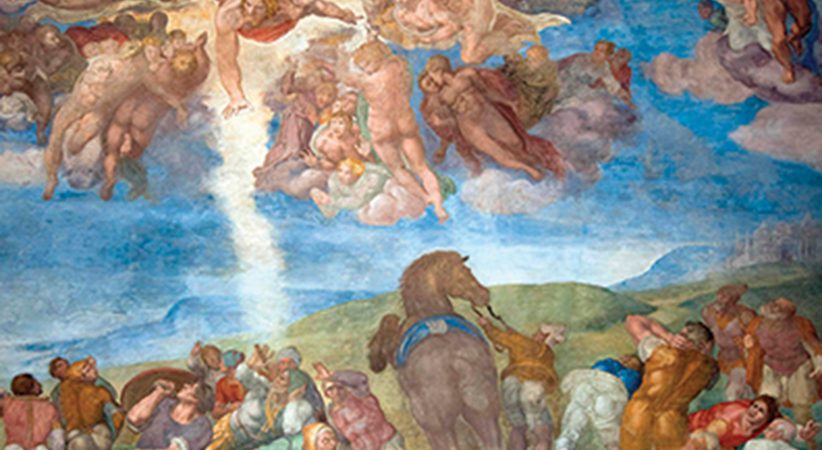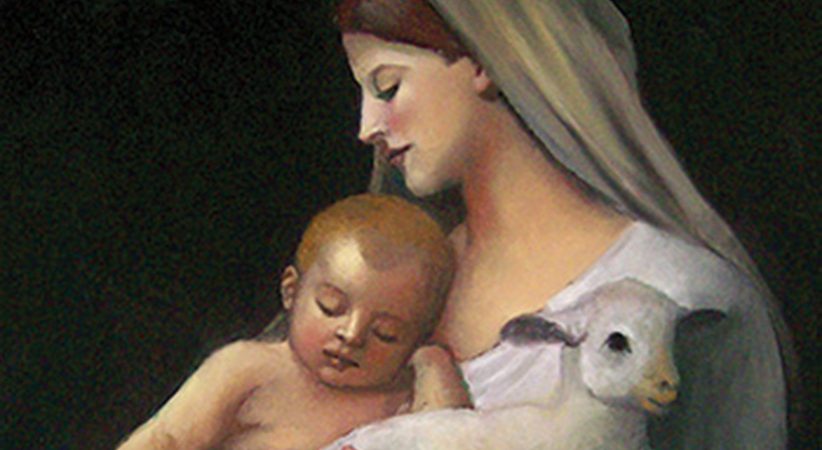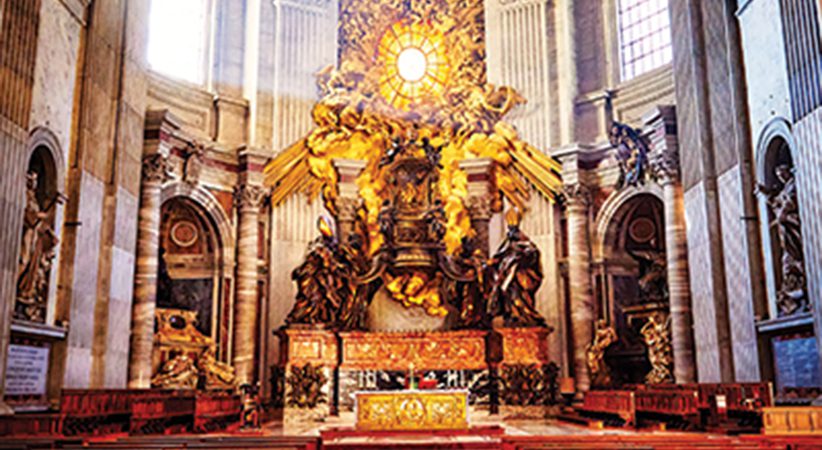St. John of the Cross
Father Terence P. Curley Comments Off on St. John of the Cross
In our secular society spirituality is often overlooked or not given its just due especially when we experience the loss of loved ones. From the faith perspective we need to help the bereaved to place their loss into the context of faith. By so doing we can help the grief-stricken to move forward and grow spiritually during times of loss.
Spirituality is not something which is merely added on to theories as a resource or a way of coping. Rather it is essential for healing life’s deepest wounds and restoring balance in our lives.
In Catholic theology there is a traditional framework for appreciating spiritual growth provided for us by great mystical saints and writers. Through their writings and talks they provide us insights for our own personal journey toward the perfection intended by our loving God. This framework offers us insights for prayer while we walk “through the valley of darkness.”
Prayerful Awareness
This spiritual framework consists of states or stages for spiritual advancement. Great saints and mystics such John of the Cross, St. Thérèse of Lisieux, St. Teresa of Avila and many others, along with our contemporary Mother Teresa, have shared much about their personal journeys which can benefit us especially during times of loss.
Whenever we experience loss there is a need for us as Christians to maintain a sense of ourselves as prayerful. Only prayer can bring us to a better perception of ourselves, of our loved ones who have died and of God. The phases we go through while we grieve are helpful in sorting out our emotional turmoil. This selfsame turmoil also affects souls and spiritual life. It is beneficial to see a parallel between our understanding of the grieving phases and our spiritual framework. Together they assist us with better ways to express our losses and realize that what we are experiencing in our prayer life shares the wisdom of mystics and saints down through the ages.
Phases of Grief and Mystical Writings
Grief may be described as occurring in phases or states: separation, transition and reincorporation. In the first phase there is considerable shock and numbness. In the second phase there is still numbness but to a far lesser degree as they become more insightful about the loss. The third phase is the state where the bereaved still experience fragmentation, yet there is much more unity in their lives. It is important to note that these phases or stages are not akin to stops on a train line where we arrive at each stage and experience that stage. Rather, like so much of life, it is a process where we gradually move from one state to another. It is messy. Some pieces move forward quickly while others lag, and the stages and their boundaries vary considerably depending on the person. Phases help us to see that there is movement even when some things are stuck. Where there is movement in one area we know there can and will be movement in other areas.
When we examine spiritual writings focused on developing the spiritual life, we see that the phases dovetail with grief work. Addressing the spiritual loss of grief becomes a doorway to intensifying and growing in spirituality. As such, the framework of spiritual masters throughout our history becomes an invaluable resource to guide us through the grief and beyond.
The three phases of traditional spirituality have a great deal to contribute to our understanding of prayer while we transition through the phases associated with grief. We can describe the traditional phases as The Stage of the Beginner (the Purgative Stage), The Stage of the Proficient (the Illuminative Stage) and The Stage of the Perfect (the Unitive Stage).
Separation and Loss Phase
( Purgative Phase )
The initial phase of grief includes a wide spectrum of emotions, physical reactions, ways of thinking, behavior and spiritual changes. When the loss is intense, this is very often a time of numbness or shock. There is disbelief and the need to accept that this is real. The cleansing or purifying of ourselves from the shock and numbness expresses itself through tears. This is known as a necessary catharsis.
Mystical writers describe purification of the spiritual life through a variety of perspectives. These are akin to the catharsis experience in the initial grief. For St. John of the Cross, who wrote about the transitions or stages in the spiritual life, the movements are a real time of spiritual crisis. It is a time of being overwhelmed and caught up in the bleakness of feelings. John called them the “dark nights,” and the “dark night of the senses.” Both of these correspond to the apostolic experience of the Passion, and the “dark night of the spirit” corresponds to the apostolic experience of loss and aloneness after the Ascension and before Pentecost. These are times of great trial for the soul. This period was one of deep grief for the apostles who locked themselves away in their grief and fear. They were very much caught up in the loss of Jesus and what that meant for them personally.
The Purgative Way relates to how we can become more aware of spirituality and loss through exploring the meaning of what we’re experiencing. There are both active and passive ways of purification which we pass through in our life. The active consists of God’s grace endeavoring to change our hearts and minds even amidst our suffering. Our participation in the Paschal Mystery of Jesus’ life, death and resurrection is the context for this phase. Even if we are unable to recognize this activity in our lives it is there as a wellspring and catalyst nudging us toward the broader context that helps us move forward.
There are also passive purifications given in this phase. They consist of dark nights of the senses and the nights of the spirit. The “dark night of the soul” has become an expression we often used to describe a person’s life in this phase of spirituality. Those who are grieving can readily relate to this phase, as many of the ways dark nights are described are so similar to the grief experience of loss. By its nature, its darkness and bereft experience it calls us to look deeper and beyond to the light. If all is loss, then what is the meaning? We stand at the boundary and look to see what is important, what is real in our lives. Our grief has stripped away the insulating distractions that have kept us from growing spiritually.
Illuminative Way
(Transitional/Intermediate Grief Phase)
The Illuminative Way is called this because the mind becomes more and more enlightened about spiritual matters and the practice of virtues. This relates to the transitional phase which moves beyond the shock and numbness and is now in this phase searching for meaning.
It is hoped that in this phase there is acceptance of the fact that we do accept our losses. Now, there must be a moving forward in matters of the spirit. The insights about our relationship with God move us toward a more theocentric way of life. We are aware of distractions and obstacles that affect our hearts and imaginations. Now that God is more in the center and our awareness of attachments which take away from this movement of our souls becomes clearer.
Unitive Way
(Reincorporation)
The Unitive Way is about personal spiritual growth toward deep communion with God. The great challenge facing the bereaved is placing loss into the wide context of religious faith. This way speaks to our trust in God and to reconciling our loss in union with our loving God. In many ways those suffering losses have gone through the dark nights and now are on the other side. They can now relate to our loving God and form a spiritual relationship with those who have died. All relationships flow from our union with God, and the ways of contemplation in this phase bring us closer and closer to that union.
Journeys in Faith
The three ways of prayer put forth in the mystical writings are ways of classifying the degrees or phases of perfection for the Christian. They provide a framework for critical concerns as we map our personal journeys. It instills in us a realization that growth in the ways of perfection is very much a process. Within this process many relationships and events occur. The anguish of grief is in need of being comforted by the supernatural life of grace. Prayerful responses to darkness and light given by the saints can assist the journey with ways to find hope along with the other theological virtues of faith and love.
Dark Nights
St. John of the Cross provided great insight to the transitions from one stage to another. His usage of the term the “dark night of the soul” emerged from his writings. The texts tell us about what he was subjected to on his journey toward union with God. Dark Night of the Soul is divided into two books that reflect the two phases of the dark night. The first phase, that of the soul, is a purification of the senses. The second phase is that of the dark night of the spirit which is far more intense than the first.
A crisis is usually time limited. Yet there are instances in the lives of the saints which illustrate prolonged crisis in this regard. Recently we witnessed how Mother Teresa of Calcutta, according to her letters, may be the most extensive example, as her “dark night” lasted from 1948 almost to her death in 1997. As a truly spirit-filled person she was constantly testing her spirituality. She did not become complacent; rather her dark night lasted for decades. While she acted and lived generously a spiritual life, she also bemoaned that all that could be seen was glimmers and sparks of the Transcendent One. She and other saints suffered greatly in seeing through a glass darkly, yet they lived exemplary lives as they quested for deeper communion.
During intense grief there are feelings of darkness and abandonment. There is a searching and yearning to experience of the presence of a loved one. The initial feelings or symptoms associated with grief change and go through transitions. Yet, most would say today that there is no real time limit for the loss of a loved one. There is that constant remembering which, given a spiritual context, allows one to cope in better ways. Our attachments and our relationships play no small part in our spiritual passages. If our primary relationship with God is in communion, then all else will follow with our other relationships.
In the Shadows as Spiritual Trial
Our ways of spiritually seeing within the dark night are more akin to night vision rather than any kind of blindness. St. John of the Cross makes the distinction for us (in the Spanish) between tineblas which means in the dark and oscura which means that things are hidden. The type of darkness being described by John of the Cross is associated with oscura . It may be likened to seeing in the dark yet not complete darkness. While we are in the dark, grace has told us without a doubt that something immense, powerful and loving is hidden from these human eyes.
It may be further asserted that darkness is not something sinister or evil. Rather it is present due to the immensity of the light of God. Our passing through the darkness is a time of spiritual trial. It is necessary that we do so as a rite of passage to receive the necessary illumination or light in our souls.
This way of describing the dark night is helpful for those who are grieving. It does not deny the pain. Rather, as with grief, we must accept it and express it in our crying out from the depths of our souls. Such expression is necessary for spiritual and emotional well-being. We cannot just skip a phase and go back to it later. Rather we need to embrace the journey through grief as a spiritual trial and a time of suffering that ultimately will be converted into joy. As there is not a time limit for grief, such a journey may last longer than we ever expect. Yet we are aware that there is this ultimate reconciling of our search accomplished only through the fire of God’s love.
Spiritual Guides for the Dark Night
In this article, we have already noted some prominent saints who underwent the dark night of the soul. There are many more in our calendar of saints who have endured this type of spiritual trial. Saints throughout the centuries have been misunderstood and certainly mischaracterized when they underwent the depths of darkness. Yet the great saints and Doctors of the Church who felt abandoned were, with the grace of God, able to completely abandon themselves into the love of God. Their yearning for communion called them to an ever deeper relationship that constantly challenged them in the darkness of their humanity.
Our Dark Nights
In our Eucharistic Prayers we always call for the intercession of the saints for help. When we are wracked by grief and loss, it is a time to call upon those saints who certainly knew darkness in their lives. Their example of ultimate trust will sustain us as it sustained them. Whether our response is profound sadness, feelings of abandonment or the search for meaning in our lives and priesthood, there are many models who can guide us towards God’s love which goes beyond all disappointment.
A Spiritual Response to Life’s Losses
We tend to overly use psychology in our society. Not every response to loss entails a therapeutic response. Our feelings of loss may be assisted by psychological insights; however, our primary response is spiritual. The spiritual response places our losses into the wider context of our journey to the Kingdom. Sometimes we have to walk through the dark valleys. We need to embrace this time of purification as an opportunity for growth and deeper integration into the spiritual life. We need to let go and let God’s grace act in our lives.
Holiness and Wholeness
This article relates the phases of darkness with the experience of bereavement. May all of us who have grieved realize that it is for us a time of intense change. We do experience a numbing of our senses which, in many instances, brings us to new spiritual discoveries about ourselves and whom or what we love. This brings us to the gift of ultimately reconciling in the presence of God. We do realize ever so much that now we look darkly through the glass at what we will one day see face to face.
Father Curley has ministered as a pastor, mental health counselor, author and educator in the areas of separation and loss. He served as president of the National Catholic Ministry to the Bereaved and is a faculty member at St. John Seminary Master of Arts in Ministry Program for the Archdiocese of Boston. His books may be accessed online at Barnes and Noble and amazon.com.





